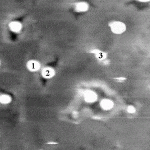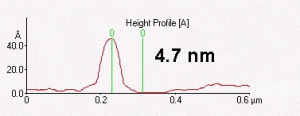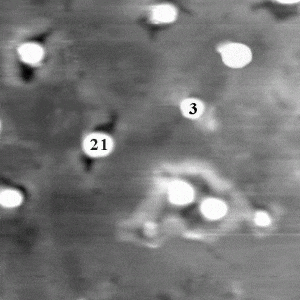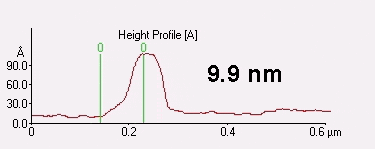Layered fabrication (also known as rapid prototyping, solid free-form fabrication and by various other designations) has been in use in the macroworld for a decade or so. At LMR we are investigating a nanometer-scale analog that is capable of producing 3-D solid objects several orders of magnitude smaller than anything built previously by layered fabrication.
The idea is to build a nanostructure by nanomanipulation (or other techniques) on a substrate surface, planarize the result by adsorbing sacrificial SAMs (self-assembled monolayers) on the substrate, repeat the process on successive layers, and finally remove the sacrificial layers. As in other layered fabrication processes, we conceptually slice the object to be produced and build it slice by slice.
The figures below show that the process is feasible. These are 500×500 nm AFM images of 5 nm Au nanoparticles on an oxidized Si surface partially covered with an ODS monolayer. Particle 1 was deposited on the original Si surface. Then an ODS layer was deposited on the Si but not on the Au. Particle 2 was deposited on the ODS layer and then pushed on top of Particle 1, as shown on the bottom figure. The line scans over Particle 2 show clearly that 1 was moved on top of 2. We deliberately did not construct a complete SAM so as to show portions of the original surface (darkest parts of the image). We are currently synthesizing molecules to construct planarizing SAMs with heights that can be tailored to the nanoparticle diameters.
Reference: A. A. G. Requicha, S. Meltzer, R. Resch, D. Lewis, B. E. Koel, and M. Thompson, “Layered nanoassembly of three-dimensional structures“, Proc. IEEE Int’l Conf. on Robotics and Automation, Seoul, Korea, pp. 3408-3411, May 21-26, 2001.




